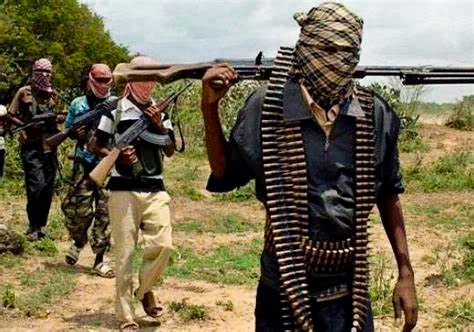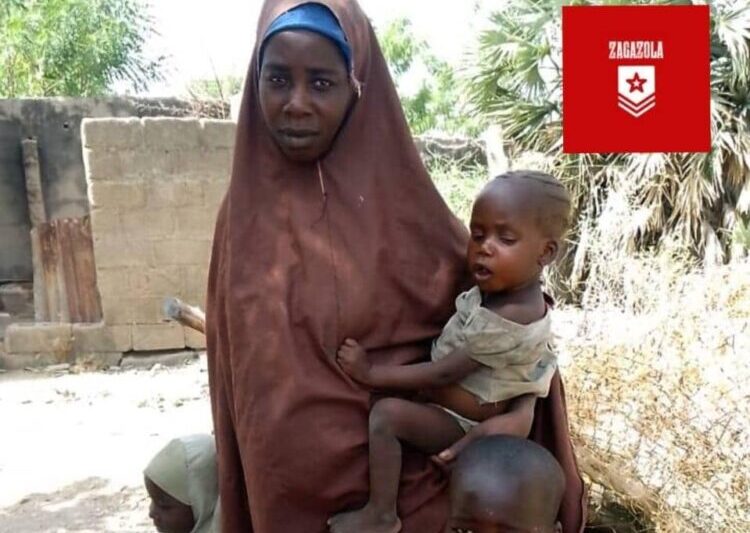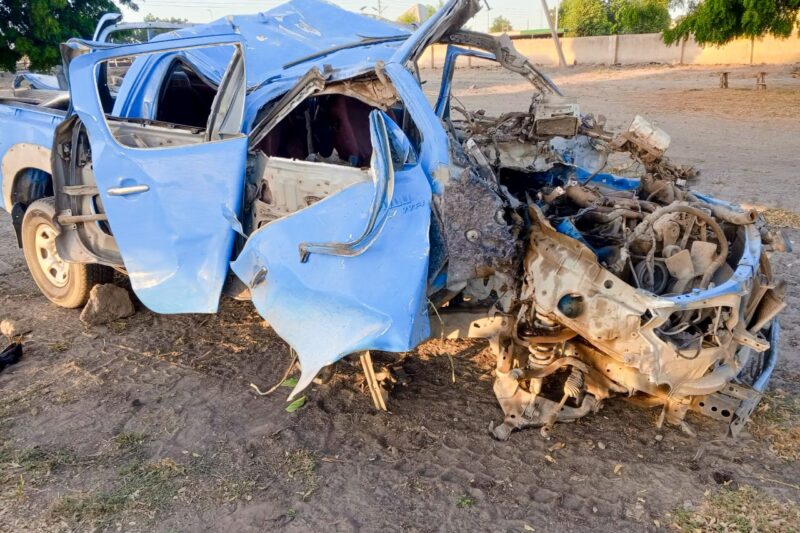This is an interview with a claimed former JAS bombmaker who recounts his personal experience, but RNI is unable to independently verify the various statements and assertions made.
In the past 8 months, many members of the armed groups which have wreaked havoc across the Lake Chad basin have surrendered to or been captured by military authorities in the region. The Theatre Commander of the northeast Nigeria task force (Operation Hadin Kai), Major General Christopher Musa, in an August 9 briefing claimed that more than seventy thousand members and associates of the Jama’tul Ahlus Sunnah Lid’da’awati wal Jihad (JAS) – better known as Boko Haram – and of the Islamic State West Africa Province (ISWAP) have surrendered to Operation Hadin Kai soldiers, and that fourteen thousand of them are real fighters.
One such person is Zakariya Modu who surrendered to the troops of Operation Hadin Kai in August 2021. The 25 years old former JAS commander, was released four months ago, after spending 9 months in three separate government-run facilities. He is currently staying with his aged mother in Maiduguri.
In an exclusive interview, Zakariya Modu spoke to Radio Ndarason International (RNI) on his nine years as a JAS commander.
LIFE IN BENISHEIK
Zakaria Modu was fifteen years old when he joined JAS.
Modu, was managing a small provision shop in a village in Kaga local government area of Borno State northeast, Nigeria. At fifteen years old Modu married his first wife, Bintu Alhaji Maina who was only 13 years old. As a married man responsibilities doubled, and life became tougher. The small business wasn’t enough to cater for his own needs and those of this newly married teenage-wife.
Bakura Yuram, a JAS member from a village called Dowma, where Modu lived, took the opportunity to recruit Modu into the sect.
‘’Initially people didn’t realise that I joined JAS, but later, when people realised that I am also a member they made life difficult for me. They told the military to come and arrest me, and that was why I and my boss (Bukura Yuram) escaped to Alagarno (the second latest insurgents’ stronghold after Sambisa Forest). I spent three years in Alagarno and only went to Sambisa when the military dislodged us from the Alagarno camp,” said Modu.
WHY I MOVED TO SAMBISA FROM ALAGARNO.
I left Alagarno for Sambisa due to frequent attacks by the Nigerian military. The location (Alagarno) was so exposed that we were vulnerable to airstrikes. Sambisa is more strategically placed than Alagarno.
“When I was in Alagarno, I was taught how to make bombs. It’s the riskiest task, but I risked my life for my job and I became an expert. Many of my colleagues died in the process, but that never stopped me from giving my best”.
When I entered to the Samisa Forest, I continue with my job of making bombs. Shekau, the longest serving-JAS leader (who was killed by ISWAP in May 2021), was very happy with us. I was promoted to lead the bomb-making team. I was reporting directly to Shekau. He (Shekau) was a big fan of radio. He was always monitoring the radio stations to get first-hand information. When someone was assigned to carry out a suicide bomb attack, Shekau would monitor the situation on his radio. If the attack was carried out successfully, he never hid his joy. There was nothing that gladdened his heart more than hearing about a successful bomb blast.
Shekau never turned down a request from us (the bomber makers).
HOW I JOINED ISWAP AND WHY I RETURNED TO THE SAMBISA FOREST
When ISWAP broke away from JAS in 2016, my boss convinced me to join ISWAP, and they were in desperate need of my services. But I didn’t last long with ISWAP because they don’t value fighters as Shekau did. Shekau provided all the needs of his fighters, while ISWAP doesn’t believe in that – you have to fight and also take care of yourself.
Apart from that, I also realised that ISWAP are not sincere, what they promised us before joining them and what we saw after joining them are two different things.
For instance, ISWAP said they didn’t believe in killing civilians, but when we joined them we realised that that is not true, they do kill civilians too.
HOW WE MADE BOMBS
I have heard many stories about how we make bombs and how we get the different materials to make them, but I can tell you that many of these stories are false.
There were frequent military airstrikes in the Sambisa Forest, and after each airstrike we would always go around on our motorbikes in search of unexploded bombs. Whenever the was an airstrike there was a possibility of getting 4 or more unexploded M23 bombs. We could easily distinguish between the exploded and the unexploded bombs. The exploded ones were shattered, but the unexploded ones are at the bottom of a deep unshattered hole. We would mobilise our team to dig out the holes and get the unexploded bombs. It’s was risky, so we didn’t mobilise more than 3 people at a time.
When we succeeded in getting unexploded bombs we would then break them into pieces and re-assemble them in the way we wanted. In that process many lives were lost. Initially we thought that all bombs are the same, and only later realised that they are not. From time to time the military review and change them. Therefore, whenever we approached them, we studied them carefully, sometimes it would take us days or even weeks to do that. To avoid wasting many lives, we would sit down far away from each other so that even if the bomb exploded, only one person would be killed.
The bombs we made were of different types for different purposes. Some were for ambush, and they would be planted on roads and roadsides, some were made for suicide bombing, while others were made to be carried on vehicles during attacks on military barracks and formations.
HOW WE PLAN ATTACKS ON MILITARY BARRACKS AND FORMATIONS
Attacking military formations is not a daily activity. It requires careful planning and execution. Depending on the formation, some require days, weeks or even months of planning before execution. Attacking military barracks requires strategy. When we made up our minds to attack a particular miliary formation or barracks, then we first mobilised and deployed our men to the location. The first group of foot-soldiers would be in disguise and would remain close to the facility, with their arms hidden. The purpose of them being there ahead of time was basically to gather intelligence and to fight when it is time to do so. They are the ones who tell us when is the best time to attack. These conversations would take place between the disguised foot-soldiers and the heavily armed fighters who were somewhere far from the barracks.
The best times to attack a military barracks or formation is around either 4:00am or 7:00pm. These two times are very important. We realised that during these two times the military were unprepared. After spending a busy night drinking and dancing in the bars, the best time for them (the military) to sleep or relax was between 2am and 4am. When the remaining squad on vehicles and motorbikes were coming to attack, they turned off the vehicles and the motorbikes and pushed them until they were very close to the barracks. We did that to avoid drawing the attention of the military. We started shooting at the same time, and when we started shooting in their direction they couldn’t resist us, and they would be very confused and terrified because they couldn’t believe how we managed to come that close. They would be disorganized and could hardly respond. And we had our men ready and waiting with their vehicles fully detonated with explosive devices to ram into the barracks and the military personnel the moment that they began to flee then. That’s how we killed and captured some of them alive, and carted away many weapons, ammunition, military trucks, uniforms and other equipment.
HOW WE INTERCEPTED CONVERSATIONS BETWEEN PILOTS AND THE CONTROL ROOM
When we realised that there were aircraft flying over the Sambisa Forest, we would turn on our radio and set the antenna, so that we could hear the conversation taking place between the pilot and the control room. There were those among us who understand English, and they translated for us, telling us what the conversation was all about. You could easily tell what the target area was, and if your own area was among them, then you evacuated.
HOW WE ABDUCTED CHIBOK GIRLS
In 2014, the government of Nigeria had declared a state of emergency in order to crush the insurgency in the northeast region. A new set of military equipment and personnel were deployed. There were many of them and even the existing troops operating in the region were a bit confused about the exact number of troops operating because there were so many, all with different outfits. When we understood this confusion it was easy for us to paint our vehicles like some of theirs, and to dress like the military. And our commander, who led the attack, was fluent in English. That’s how we easily passed through some military checkpoints without any fear.
When we were already inside the school premises, we saw the schoolgirls were all terrified. The commander who led the attack spoke to them in fluent English and they relaxed a bit. He told them that we were the Nigerian army, and we were there to assist them because Boko Haram was currently attacking Chibok town – that’s how he convinced them, and why they got into our vehicles.
On our way to the Sambisa Forest, some of them escaped when they realised that we are not the Nigerian army, but it was already too late. We took them straight to the Sambisa Forest; they spent all their time in the Sambisa Forest. But from time to time we did change their locations inside the forest, especially when there were frequent attacks by the military in their rescue effort. Some of the girls were killed by the military airstrikes. Many of them were married off, some were released, and some are still in the bush. I don’t know if they wanted to come out because the chances are there.
CASH FLOW AND LOGISTIC SUPPLY
Money was not a problem while inside Sambisa. We never ran out of cash. Our major source of income was through kidnapping for ransom. For instance, when we abducted the Chibok girls, the government was desperate to secure their release. I can remember, when the first group of the Chibok girls were released to the government, the ransom money was paid in cash euro notes. Euros werewere all over the Sambisa Forest. I never saw any foreign currency before that time. We wanted to change the euros to Naira, but initially t wass difficult to do that. We later took the money to Cameroon and to Mubi, a town on the border with Cameroon, and successfully changed it. And later still we were introduced to some cash vendors behind Muna village, close to Maiduguri.
We had different ways of getting essentials such as sugar, medicine, fuel/diesel, batteries, tea and spices. We collaborated with some locals to provide us with all our needs. We bought them vehicles to work as taxi drivers, and they supplied us. We had many of them and we had different meeting points to collect the goods.
FIGHTING INSIDE THE SAMBISA FOREST
It’s true that the military do come to the Sambisa Forest frequently, but they hardly succeed. The military can’t enter the Sambisa Forest without us knowing. They start by shooting heavy artillery from far, I don’t know why are they do that. They can’t come to us silently as we do. When we heard them coming, then we would tell our men to plant bombs on all the possible routes, and then we would evacuate our families to the safe zone where they usually hide – it was a very protected and strategic hideout, and the military can’t go there. We, the fighters, have our own hideouts and we would gather there. We would be monitoring the military from where we were. When we heard an explosion we would know where they were because we know where we planted the bombs. If they recorded many casualties then sometimes they would decide not to proceed and withdraw. If the casualties were few they would continue. But when they managed to enter our camps, they wouldn’t see anyone. They would destroy and burn down almost everything they saw standing, including our livestock.
In a situation like that, you see them shouting, calling us names, shooting anyhow, thinking they have recorded a success. At that point, if they felt satisfied, they would sometimes decide to go back. And sometimes they would decide to camp there for some few days. We were nearby observing them from where we were. If they decided to camp we would not attack them that same day. After one or two days, when they feel more relaxed, then we would attack them in the night or early morning, but usually we prepared early morning attacks for the reason which I mentioned earlier.
THE NEXUS BETWEEN JAS AND ARMED BANDITS OPERATING IN THE NORTHWEST
When Shekau was alive, he decided to extend hands to the bandits operating from the northwest region. He deployed some men to Zamfara, where we (JAS) open an alternative camp. The reasons for having another camp in Zamfara were two. One, when the military intensified offensive on the Sambisa Forest, attacking us frequently, Shekau decided to have another camp in Zamfara and he strategically moved some of his men and equipment there. Two, he wanted to join forces with the armed men operating in the northwestern region to expand operations beyond the Lake Chad region. By doing so, he diverted the attention of the military.
When the JAS men were initially deployed to Zamfara, the bandits welcomed them, but they were not very comfortable with our men. The bandits realised that our activities were ideologically motivated, and then they became reluctant and gradually vacated that camp for another separate one. But the relationship continued. For instance, after the abduction of the Kanakara schoolboys by the bandits, they informed Shekau about the abduction, and he claimed the responsibility of abducting them in a video message. When the video was made public many analysts and security observers doubted him, saying that he was not the one who abducted them because the schoolboys were not shown in the video. When that happened then the bandits filmed the schoolboys and sent him the video. That’s how he presented the schoolboys in second video released, and no one doubted him anymore. That clearly shows the relationship between the two parties.
INSIDE THE SAMBISA FOREST
The place called Sambisa Forest is a vast, thick forest with tall trees which covers huge mountains. Prior to our occupation there were communities within and around the forest. When we occupied the place, some of the communities were expelled, some displaced, some escaped, and some joined us, while some stayed on their own.
I stayed inside Sambisa for nine years, but there are some many places which I have never been to. This to show how big it is.
There are so many settlements within the Sambisa Forest headed by different commanders, you needed to seek for permission to enter some of them.
We did have almost everything one needed to survive inside the Sambisa Forest. I don’t think the difference between living in Maiduguri and in Sambisa is so much. There are hospitals, Islamic schools, water facilities, electricity, farming and commercial activities. Among us insurgents there are mechanics, doctors, engineers and trained fighters.
HOW HOSPITALS OPERATE IN SAMBISA
The first set of doctors operating in our health facilities were experienced doctors we abducted from their hospitals in Maiduguri and beyond. We didn’t kill them; we asked them to train selected men who were assigned to be health workers. I know many of these doctors we abducted to Sambisa. They trained our men on different aspects of medical care, and they did well. In a situation where the existing doctors came across a specific case which was beyond their knowledge, the doctors would refer us to the one who specialized in that field, and we would then abduct that one.
THE LIFE OF WOMEN AND CHILDREN IN SAMBISA
Women were not allowed to go outside. They must remain at home all the time. They needed a very concrete reason to be moving around. Women couldn’t move alone without a muharram (husband, son or biological brother). Girls were married off at the age of 13-14, and it wasn’t allowed for them to stay too long without being married. Women were allowed to go to the available female Islamic schools to study, but their bodies must be covered completely before going out.
Women were also encouraged to commit suicide bombing; they were encouraged to do so as their own contribution to the “jihad” process and they were always ready. Women did follow us to the battlefields, they were the ones committing suicide.
CHILDREN
Between the ages of 4-13, children were encouraged to study the Qur’an, while between 14-15 they had to start participating in the training process. Among the combatants, there were ones whose job it is to train the younger ones. There were many children inside the Sambisa Forest because of the frequent marital activities taking place there.
RATING THE MILITARY
I don’t think the military effort alone can end this war. I took part in almost all the major battles with the military, and I know what the military is capable of doing. I don’t want to go into the details, but surely the military alone can’t end this war. I think the best time to end the war is now, with this massive number of defections. But by all indications, the government isn’t utilizing this opportunity properly. If this opportunity is missed, I don’t know when the insurgency will end.
WHY I SURRENDER
After the death of Abubakar Shekau, the command chain was broken and life was no longer the same in Sambisa. The Islamic State West Africa Province (ISWAP) took over Shekau’s territory. They wanted us to accept their invitation to join forces with them, but I decided not to work with them, because I worked with them in the past and I know how they operate. They they hardly keep their word. ISWAP is full of “deception” I couldn’t trust them anymore and that’s was why I decided to surrender.
I was among the first set of defectors. I surrendered to the Nigerian army located in Bama town in August 2021. I came with more than five rifles, and I gave them all to the military on the spot.
The soldiers were so excited. They took us to Maiduguri and kept us in one small facility at Shokwori community in Maiduguri. The Borno State governor came and met us at the facility. I- I can still recall how excited he was.
He directed the military to move us to the other facility in Bulumkutu area in Maiduguri, and finally to the Hajj Camp. This was the last place we were kept at before we were finally released to our families after spending 9 months in the government facilities.
LIFE IN MAIDGURI
Life in Maiduguri is “hell”. When we were kept at the government facilities, the government provided three meals per day and ten thousand naira was given to us at the end of every month. Life was good when we were kept in those places. Apart from the meals and money given to us by the government, we also surrendered with a lot of money. I alone, came out with seven hundred-thousand-naira cash with me. I mismanaged the money when I heard the promise made to us by governor Babagana Umara Zulum when he first visited us. I am still regretting spending that huge amount of money. Governor Zulum told us that we will never regret being here, that he would not abandon us, and that his government would do anything possible to make our life better and productive. But here we are today; no skills, no money, no job, no shelter since our release over three months ago. When we were at the government-run facility we thought life was poor, after we were released we realised that the life in there was a “heaven”.
The very day we were released, the government gave us one hundred thousand naira each, they opened bank accounts for us, and promised to credit our bank accounts to begin a new life. As I am speaking to you now, none of us has received a penny from the government again.
I have two wives and three children. My wives are staying with their families in Potiskum local government area of Yobe State with my kids because I can’t afford to rent a house to bring them to Maiduguri. What type of life is this? Is this what they government is calling us for? As it is now, I don’t have a penny with me for the more than a week. Am I not a human being? I need to eat like any one does, but I am going to the bed with an empty belly. I can’t rent a house, I am staying with my aged mother in the same room. That is where I sleep. When I surrendered, I had more than 20 bags of grain in my house, but here I am today going to bed with an empty belly. As you see me now, I can’t go to farm because we are very much aware that our former colleagues are closely following all our movements. If we move outside Maiduguri, anything can happen to us! Our defection was a major setback to the sect and they will never forgive us.
I am very disappointed. Had I known that this is the life the government is calling me for, I would not have lain down my arms and come here – I would have preferred to lay my arms down and go somewhere else, but not here.
There were two of us who surrendered together the same day and we stayed for 9 months together at the government-run facilities, until our release. Three months after our release, life was as tough as it is right now. The others couldn’t resist and decided to convive with our former colleagues who remained in the in the bush, supplying them with fuel and food. Two days before the recent Eid Mubarak, celebrated on the 9 July, the military traced, arrest and killed two of them. Did the government investigate why they were conniving with their former colleagues even after surrendering to the government forces? I think they should do that before taking any decision. If the government do not ameliorate this hardship, I don’t know what is going to happen in future.








